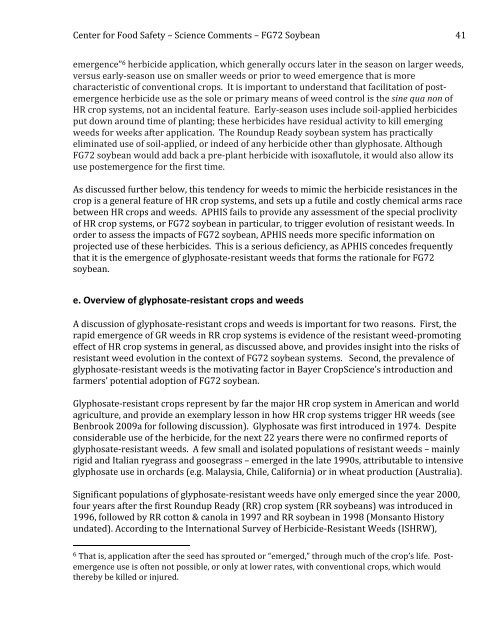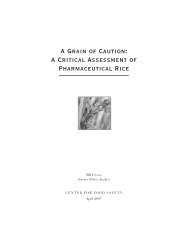a four-fold rise - Center for Food Safety
a four-fold rise - Center for Food Safety
a four-fold rise - Center for Food Safety
Create successful ePaper yourself
Turn your PDF publications into a flip-book with our unique Google optimized e-Paper software.
<strong>Center</strong> <strong>for</strong> <strong>Food</strong> <strong>Safety</strong> – Science Comments – FG72 Soybean <br />
41 <br />
emergence” 6 herbicide application, which generally occurs later in the season on larger weeds, <br />
versus early-‐season use on smaller weeds or prior to weed emergence that is more <br />
characteristic of conventional crops. It is important to understand that facilitation of post-emergence<br />
herbicide use as the sole or primary means of weed control is the sine qua non of <br />
HR crop systems, not an incidental feature. Early-‐season uses include soil-‐applied herbicides <br />
put down around time of planting; these herbicides have residual activity to kill emerging <br />
weeds <strong>for</strong> weeks after application. The Roundup Ready soybean system has practically <br />
eliminated use of soil-‐applied, or indeed of any herbicide other than glyphosate. Although <br />
FG72 soybean would add back a pre-‐plant herbicide with isoxaflutole, it would also allow its <br />
use postemergence <strong>for</strong> the first time. <br />
As discussed further below, this tendency <strong>for</strong> weeds to mimic the herbicide resistances in the <br />
crop is a general feature of HR crop systems, and sets up a futile and costly chemical arms race <br />
between HR crops and weeds. APHIS fails to provide any assessment of the special proclivity <br />
of HR crop systems, or FG72 soybean in particular, to trigger evolution of resistant weeds. In <br />
order to assess the impacts of FG72 soybean, APHIS needs more specific in<strong>for</strong>mation on <br />
projected use of these herbicides. This is a serious deficiency, as APHIS concedes frequently <br />
that it is the emergence of glyphosate-‐resistant weeds that <strong>for</strong>ms the rationale <strong>for</strong> FG72 <br />
soybean. <br />
e. Overview of glyphosate-‐resistant crops and weeds <br />
A discussion of glyphosate-‐resistant crops and weeds is important <strong>for</strong> two reasons. First, the <br />
rapid emergence of GR weeds in RR crop systems is evidence of the resistant weed-‐promoting <br />
effect of HR crop systems in general, as discussed above, and provides insight into the risks of <br />
resistant weed evolution in the context of FG72 soybean systems. Second, the prevalence of <br />
glyphosate-‐resistant weeds is the motivating factor in Bayer CropScience’s introduction and <br />
farmers’ potential adoption of FG72 soybean. <br />
Glyphosate-‐resistant crops represent by far the major HR crop system in American and world <br />
agriculture, and provide an exemplary lesson in how HR crop systems trigger HR weeds (see <br />
Benbrook 2009a <strong>for</strong> following discussion). Glyphosate was first introduced in 1974. Despite <br />
considerable use of the herbicide, <strong>for</strong> the next 22 years there were no confirmed reports of <br />
glyphosate-‐resistant weeds. A few small and isolated populations of resistant weeds – mainly <br />
rigid and Italian ryegrass and goosegrass – emerged in the late 1990s, attributable to intensive <br />
glyphosate use in orchards (e.g. Malaysia, Chile, Cali<strong>for</strong>nia) or in wheat production (Australia). <br />
Significant populations of glyphosate-‐resistant weeds have only emerged since the year 2000, <br />
<strong>four</strong> years after the first Roundup Ready (RR) crop system (RR soybeans) was introduced in <br />
1996, followed by RR cotton & canola in 1997 and RR soybean in 1998 (Monsanto History <br />
undated). According to the International Survey of Herbicide-‐Resistant Weeds (ISHRW), <br />
6 That is, application after the seed has sprouted or “emerged,” through much of the crop’s life. Post-emergence<br />
use is often not possible, or only at lower rates, with conventional crops, which would <br />
thereby be killed or injured.







